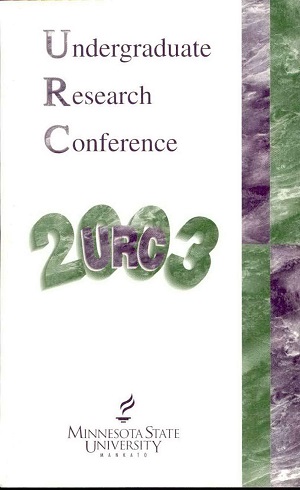Purification of DNA Polymerase
Location
CSU
Student's Major
Biological Sciences
Student's College
Science, Engineering and Technology
Mentor's Name
Marilyn Hart
Mentor's Department
Biological Sciences
Mentor's College
Science, Engineering and Technology
Description
DNA polymerase is an enzyme that catalyzes the synthesis of deoxyribonucleic acid (DNA) from deoxyribonucleotides. We are attempting to purify a modified DNA polymerase from the bacterium Thermus aquaticus. Thermus aquaticus resides in an environment where the temperature ranges from 70-80°C, requiring that its DNA polymerase have the ability to remain stable through repeated high-heat conditions. Because of this feature, DNA polymerase from Thermus aquaticus is a useful molecular biology reagent. To purify the enzyme, Escherichia coli containing an inducible plasmid form of the DNA polymerase gene were grown to early log phase. The promoter of the vector was induced to express the polymerase protein, and the cells were harvested and lysed. The DNA polymerase was then recovered from this lysate by precipitation with polyethyleneimine and purified from the bacterial protein background using anion exchange chromatography. Throughout the purification, the presence of the enzyme in the lysate was monitored by two techniques: Polymerase Chain Reaction (PGR) and Sodium Dodecyl Sulfate Polyacrylamide Gel Electrophoresis (SDSPAGE). Finally, the purified protein was pooled and dialyzed with storage buffer.
Purification of DNA Polymerase
CSU
DNA polymerase is an enzyme that catalyzes the synthesis of deoxyribonucleic acid (DNA) from deoxyribonucleotides. We are attempting to purify a modified DNA polymerase from the bacterium Thermus aquaticus. Thermus aquaticus resides in an environment where the temperature ranges from 70-80°C, requiring that its DNA polymerase have the ability to remain stable through repeated high-heat conditions. Because of this feature, DNA polymerase from Thermus aquaticus is a useful molecular biology reagent. To purify the enzyme, Escherichia coli containing an inducible plasmid form of the DNA polymerase gene were grown to early log phase. The promoter of the vector was induced to express the polymerase protein, and the cells were harvested and lysed. The DNA polymerase was then recovered from this lysate by precipitation with polyethyleneimine and purified from the bacterial protein background using anion exchange chromatography. Throughout the purification, the presence of the enzyme in the lysate was monitored by two techniques: Polymerase Chain Reaction (PGR) and Sodium Dodecyl Sulfate Polyacrylamide Gel Electrophoresis (SDSPAGE). Finally, the purified protein was pooled and dialyzed with storage buffer.



